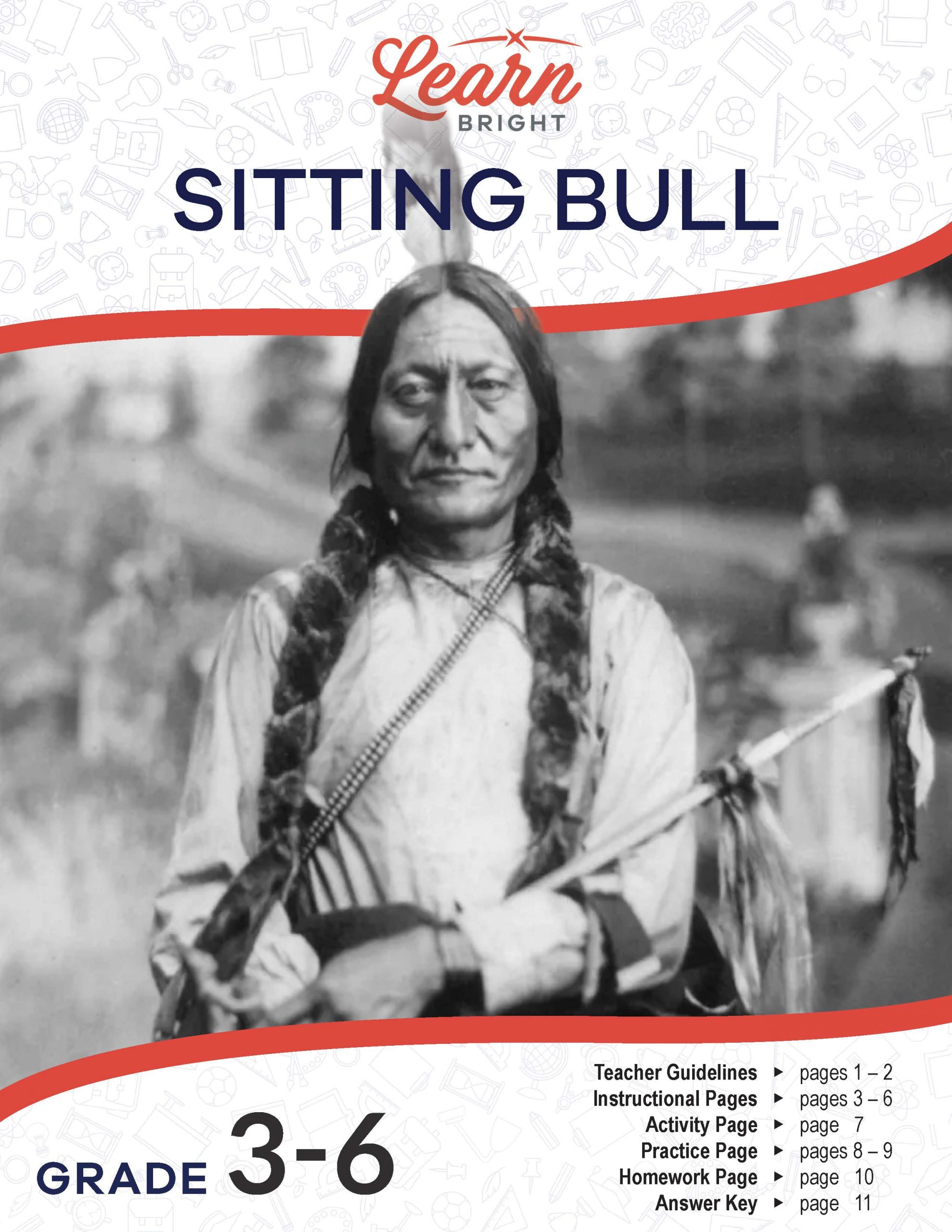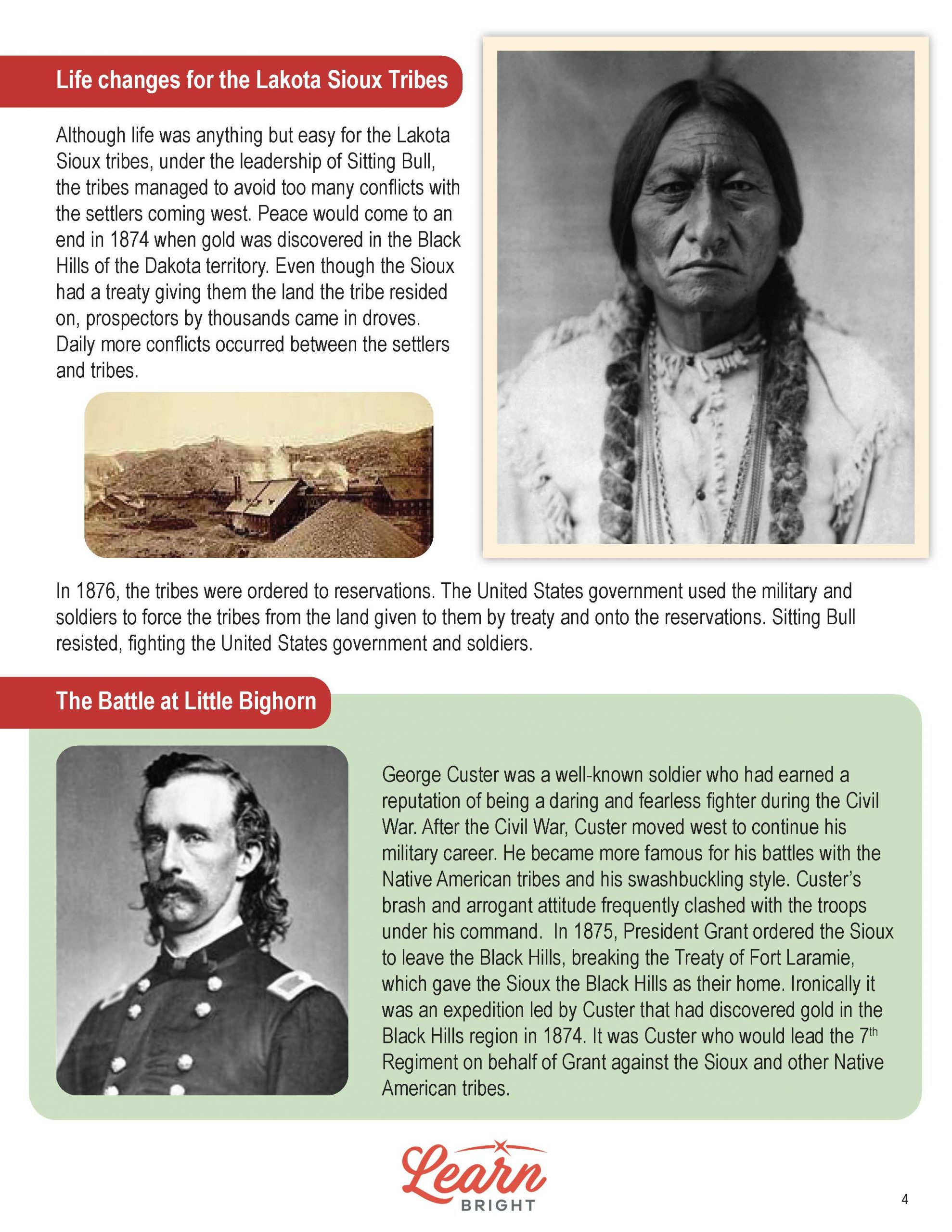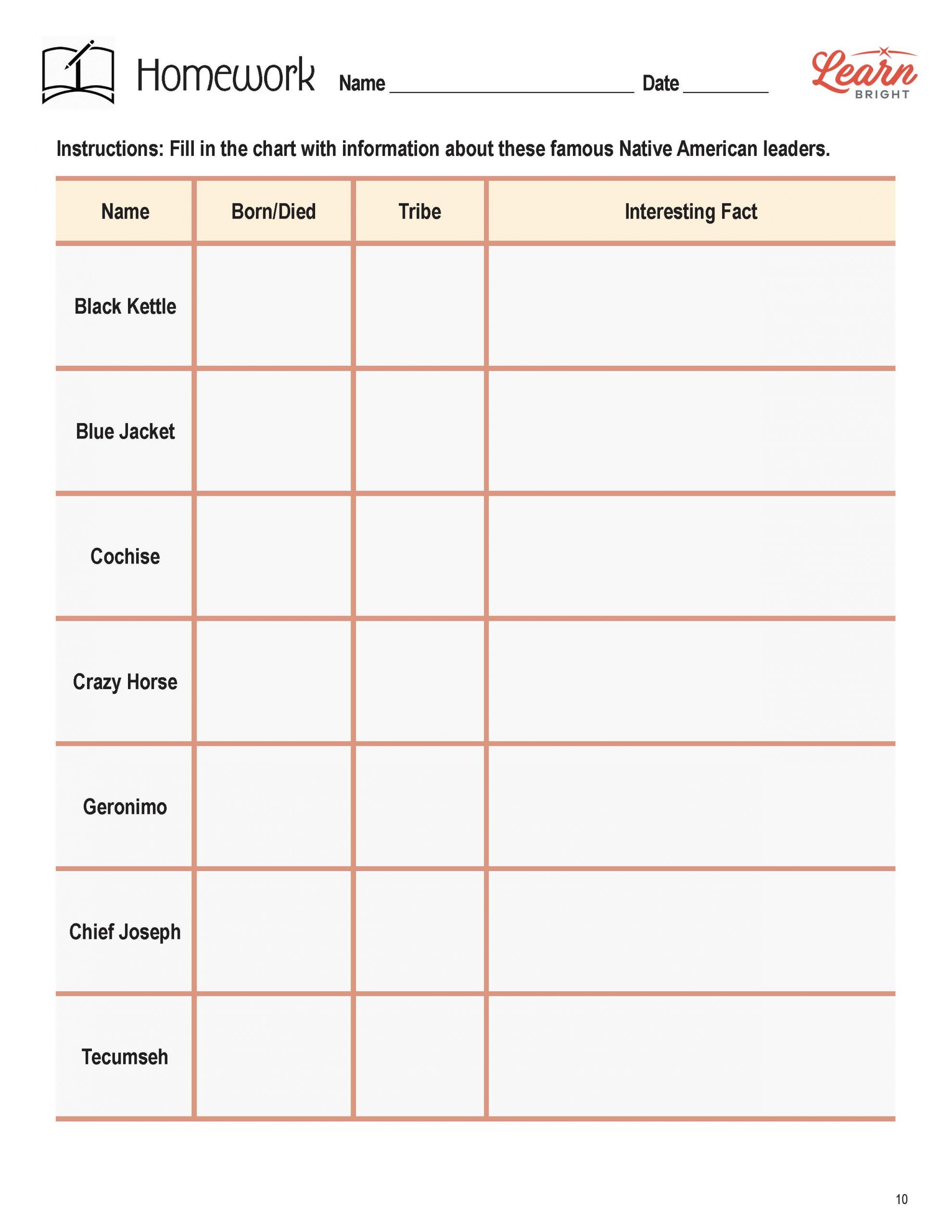Description
What our Sitting Bull lesson plan includes
Lesson Objectives and Overview: Sitting Bull covers everything from Sitting Bull’s early life to his eventual leadership of the Lakota people. Students will learn about his struggles to protect his people from white settlers moving west, and how he eventually came to understand and respect a culture that was different from his own. By the end of the lesson, students will have a greater understanding not only of Sitting Bull and his impact on history, but also of their own cultural attitudes and how they can impact others. This lesson is for students in 3rd grade, 4th grade, 5th grade, and 6th grade.
Classroom Procedure
Every lesson plan provides you with a classroom procedure page that outlines a step-by-step guide to follow. You do not have to follow the guide exactly. The guide helps you organize the lesson and details when to hand out worksheets. It also lists information in the yellow box that you might find useful. You will find the lesson objectives, state standards, and number of class sessions the lesson should take to complete in this area. In addition, it describes the supplies you will need as well as what and how you need to prepare beforehand. The supplies you will need are pencils, pens, and highlighters.
Options for Lesson
Included with this lesson is an “Options for Lesson” section that lists a number of suggestions for activities to add to the lesson or substitutions for the ones already in the lesson. For this lesson, one of the only suggested additions is to introduce or close the lesson by watching the film clip listed in the lesson, where Sitting Bull’s great-grandson tells his great grandfather’s oral history. You can also use the Epic website, also listed in the lesson, to download a short book about Sitting Bull to read as a class.
Teacher Notes
The teacher notes page includes a paragraph with additional guidelines and things to think about as you begin to plan your lesson. This page also includes lines that you can use to add your own notes as you’re preparing for this lesson.
SITTING BULL LESSON PLAN CONTENT PAGES
Early Years
The Sitting Bull lesson plan includes four content pages. In 1831, the United States had 24 states, Andrew Jackson was president, and there were 13 million people living in the U.S., two million of whom were slaves. Settlers moved west largely due to the influence of Manifest Destiny, or the idea that it was American’s destiny to extend the U.S. across the entire continent.
The demand for land increased as people moved west. In turn, the efforts to remove native peoples from their lands increased as well. President Jackson signed the Indian Removal Act on May 30, 1830. This act authorized the government to remove native peoples by force and relocate them to the unsettled lands to the west of the existing states.
Sitting Bull was born in a part of the United States that had only been part of the United States for 27 years. The U.S. acquired this land from France as part of the Louisiana Purchase. Much later on, in 1889, this land became the state of South Dakota. Lewis and Clark established a permanent settlement at Fort Pierre. Fights became common between the Native Americans, like the Sioux Indians, and the settlers who came to take their land away from them.
The climate in the Dakotas can be extreme. In winter, their temperatures often drop below freezing and they sometimes see wind chills as low as -10°F. In summer, they have excess heat and often see temperatures above 100°F. The land has rolling plains and grasslands. This is where Sitting Bull was born in 1831.
Sitting Bull was the son of Returns-Again, a famous Sioux warrior. He was not originally named Sitting Bull, and they called him “Slow” in his early years because he hadn’t shown his father’s skill as a warrior. He had to earn a warrior’s name and was expected to follow in his father’s footsteps. At 14, during a fight with a rival tribe, he touched a Crow warrior with a coup stick and earned his name: Tatanka Youtanka, or Sitting Bull. Warriors who landed a blow against an enemy gained a coup, or notches and feathers for bravery on their coup stick.
Because of Sitting Bull’s repeated acts of courage and bravery, he soon became the leader of the Sioux Tribe and Lakota Nation. He was their leader until he died in 1890.
Life Changes for the Lakota Sioux Tribes
Under Sitting Bull’s leadership, the Lakata Sioux tribes saw relative stability, though life was never easy. He managed to avoid major conflicts with settlers. However, this all ended in 1874 when the settlers discovered gold in the Black Hills of the Dakotas. The Sioux treaty gave them the land they lived on, but prospectors still showed up in larger numbers. Conflicts started to happen daily.
Then, in 1876, the government ordered the tribes to move to reservations. The United States government ordered the military and its soldiers to remove the tribes by force onto the reservations, in violation of their treaty. Sitting Bull resisted and fought the U.S. government.
The Battle at Little Bighorn
George Custer gained his reputation as a fearless soldier during the Civil War. After the Civil War, he moved west and continued his military career, becoming more famous due to the many battles he fought against the native people. He was arrogant and often fought with the people under his command. Then, in 1875, President Grant ordered the removal of the Sioux from the Black Hills, breaking the Treaty of Fort Laramie, which had officially given the Sioux the land. An expedition led by Custer found gold in the Black Hills in 1874, and he would later lead the 7th Regiment for Grant against the Sioux and the other Native American tribes that fought with them.
On June 25, 1876, Custer’s scouts found a camp where Sitting Bull, Crazy Horse, and about 2,000 other members of the Lakota, Sioux, Cheyenne, and Arapaho tribes were meeting. Instead of waiting for reinforcements, Custer decided to attack. He split his 600 troops into four groups and commanded them to attack. Crazy Horse organized his troops to fight them while Sitting Bull protected the women and children in the camp. In less than an hour, Custer and his troops were dead. Historians think that Custer and more than 260 of his soldiers died in battle, along with 31 Native American warriors. Today, we consider this battle one of the worst defeats for the U.S. military during this period where they worked to get rid of the Native American tribes and remove them from their land.
Sitting Bull moved his tribe to Canada until 1881, when he returned to the Dakotas. He lived as a prisoner confined to the reservation until 1883.
Later Life
Upon Sitting Bull’s return to the Dakotas, he discovered that things were very different than when he moved his tribe to Canada. The government no longer allowed them to roam across the plains freely. In 1884, he gained permission to travel. During his travels, he met Annie Oakley who then introduced him to Buffalo Bill Cody. Cody managed a wild west show that included sharpshooting, storytelling, and more. He added Sitting Bull to the show as an attraction.
Life as a performer was not good for Sitting Bull, as crowds often heckled him. The brother of a solider killed at Little Big Horn even attacked him once. At the end of the show, Sitting Bull went home. The government did not give him permission to travel again.
The Ghost Dance Movement
After Sitting Bull’s return, a mystic named Wovoka started having visions. He claimed that the white man would disappear if the Native Americans performed Ghost Dances. These were a spiritual movement with a long history in their culture. This movement spread rapidly across the tribes in the reservations. Sitting Bull participated eagerly.
Meanwhile, the U.S. government sent spies to watch the dances. The Bureau of Indian Affairs soon banned the dance, believing that the Ghost Dance Movement could cause the tribes to revolt against the government.
The Indian Police came to arrest Sitting Bull for encouraging the movement on December 15, 1890. However, Sitting Bull refused to leave. Crowds gathered and a gun went off, hitting a member of the Indian Police. There was chaos, and the Indian Police fired their guns, hitting Sitting Bull in the chest and head. Sitting Bull died. A few weeks later, the military killed more than 150 Sioux Indians at Wounded Knee. Many people believe that this was a direct result of the U.S. government’s murder of Sitting Bull.
SITTING BULL LESSON PLAN WORKSHEETS
The Sitting Bull lesson plan includes three worksheets: an activity worksheet, a practice worksheet, and a homework assignment. You can refer to the guide on the classroom procedure page to determine when to hand out each worksheet.
RESEARCH ACTIVITY WORKSHEET
The activity worksheet asks students to research the Native American tribes that lived on the Great Plains. They will label and shade the territories of each. They will also answer a few questions about the region.
QUOTES PRACTICE WORKSHEET
For the practice worksheet, students will read quotes and write down what they learn about the personalities of the writers from reading the quotes.
SITTING BULL HOMEWORK ASSIGNMENT
The homework assignment asks students to fill in the provided chart with information about different Native American leaders.
Worksheet Answer Keys
This lesson plan includes answer keys for the practice worksheet and the homework assignment. If you choose to administer the lesson pages to your students via PDF, you will need to save a new file that omits these pages. Otherwise, you can simply print out the applicable pages and keep these as reference for yourself when grading assignments.










